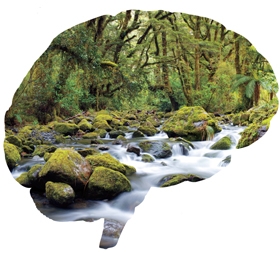Your Dog's Brain Is a Rain Forest

When I take Frankie, my small terrier mix, out for a walk, he tends to avoid contact with other people and other dogs. “He’s shy,” I tell fellow dog walkers who want to approach, and often add, “But you should see him at home. He’s king of his domain, happy and brave.”
Of course dogs behave differently in different situations. So why do I feel compelled to draw various strangers’ attention to Frankie’s at-home personality? It’s because I, like many others, carry around a notion in my head of the ideal dog -- outgoing (but not too much), friendly, playful, obedient -- and consider any deviation from it embarrassing.
I never really thought much about it until recently, but we also carry around similar notions of the ideal human. "Your Brain is a Rain Forest," a fascinating article by Thomas Armstrong, puts it like this:
We have become accustomed as a culture to the idea that significant segments of the population are afflicted with neurologically based disorders such as “learning disabilities,” “attention deficit hyperactivity disorder” and “Asperger syndrome”: conditions unheard of 60 years ago. Now, even newer disabilities are being considered for the next edition of the DSM [Diagnostic and Statistical Manual of the American Psychiatric Association], due out in 2012, including relational disorder, sexual behavior disorders and video game addiction.
The National Institute of Mental Health (NIMH) has reported that more than one-quarter of all adults in the U.S. suffer from a diagnosable mental disorder in any given year. It seems to me that we’re moving toward a day when virtually every single individual alive may be regarded as afflicted with a neurologically based mental disorder to one degree or another.
As Armstrong points out, the norm is always a product of shifting cultural values. He cites the example of a pre-Civil War medical article that discussed a mental disorder called “drapetomania,” a syndrome in slaves that caused them to run away from their owners. He also notes that, until the early 1970s, homosexuality was considered a mental illness by the American Psychiatric Association.
The main thrust of the article, which is an excerpt from the book Neurodiversity: Discovering the Extraordinary Gifts of Autism, ADHD, Dyslexia and Other Brain Differences (Da Capo 2010), is that humans have neurological systems that are distinct from one another but interconnected. We should see that “differences between human beings with respect to a particular quality -- say sociability -- exist along a continuum,” just as distinct natural landscapes do in a biodiverse Earth. Certain environments, he posits, are more suitable to different brain types than others -- Silicon Valley for people who have Aspergers, for example -- so a more productive way of approaching deviations from the accepted norm is to find niches in which individuals flourish, rather than trying to make them fit into places that are uncomfortable for them.
Canine brains are sufficiently similar to human brains that we use dogs to test drugs designed to treat mental disorders; Prozac is just one example. We are always looking for tools to enhance and supplement training. Why not consider how canine neurology might differ from dog to dog in the same way as human neurology does and study the environments to which our dogs’ individual brain configurations might be best suited? Clearly my home is a comfortable niche for Frankie. That should be cause for celebration, not embarrassment.




